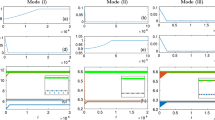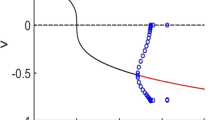Abstract
The quadratic integrate-and-fire (QIF) model with adaptation is commonly used as an elementary neuronal model that reproduces the main characteristics of real neurons. In this paper, we introduce a QIF neuron with a nonlinear adaptive current. This model reproduces the neuron-computational features of real neurons and is analytically tractable. It is shown that under a constant current input chaotic firing is possible. In contrast to previous study the neuron is not sinusoidally forced. We show that the spike-triggered adaptation is a key parameter to understand how chaos is generated.





Similar content being viewed by others
References
Aihara K, Matsumoto G, Ikegaya Y (1984) Periodic and non-periodic responses of a periodically forced hodgkin-huxley oscillator. J Theor Biol 109:249–269
Berry MJ, Warland DK, Meister M (1997) The structure and precision of retinal spike trains. Proc Natl Acad Sci USA 94:5411–5416
Brette R (2008) The cauchy problem for one-dimensional spiking neuron models. Cogn Neurodyn 2:21–27
Brette R, Gerstner W (2005) Adaptive exponential integrate-and-fire model as an effective description of neuronal activity. J Neurophysiol 94:3637–3642
Brette R, Guigon E (2003) Reliability of spike timing is a general property of spiking model neurons. Neural Comput 15:279–308
Chacron MJ, Pakdaman K, Longtin A (2003) Interspike interval correlations, memory, adaptation, and refractoriness in a leaky integrate-and-fire model with threshold fatigue. Neural Comput 15:253–278
Chacron MJ, Longtin A, Pakdaman K (2004) Chaotic firing in the sinusoidally forced leaky integrate-and-fire model with threshold fatigue. Physica D 192:138–160
Coombes S (1999) Liapunov exponents and mode-locked solutions for integrate-and-fire dynamical systems. Phys Lett A 255(1–2):49–57
de Ruyter van Steveninck RR, Lewen GD, Strong SP, Koberle R, Bialek W (1997) Reproducibility and variability in neural spike trains. Science 275:1805–1808
Ermentrout B (1996) Type I membranes, phase resetting curves, and synchrony. Neural Comput 8:979–1001
Ermentrout B, Kopell N (1986) Parabolic bursting in an excitable system coupled with a slow oscillation. SIAM J Appl Math 46:233–253
Ermentrout B, Pascal M, Gutkin B (2001) The effects of spike frequency adaptation and negative feedback on the synchronization of neural oscillators. Neural Comput 13:1285–1310
Gutkin B, Ermentrout B (1998) Dynamics of membrane excitability determine interspike interval variability: A link between spike generation mechanisms and cortical spike train statistics. Neural Comput 10:1047–1065
Hayashi H, Ishizuka S, Ohta M, Hirakawa K (1982) Chaotic behavior in the onchidium giant neuron under sinusoidal forcing. Phys Lett A 88:435–438
Izhikevich EM (2000) Neural excitability, spiking, and bursting. Int J Bifurcat Chaos 10:1171–1266
Izhikevich EM (2003) Simple model of spiking neurons. IEEE Trans Neural Netw 14:1569–1572
Izhikevich EM (2004) Which model to use for cortical spiking neurons? IEEE Trans Neural Netw 15:1063–1070
Izhikevich EM (2007) Dynamical systems in neuroscience: the geometry of excitability and bursting. MIT, Cambridge, USA
Li T-Y, Yorke JA (1975) Period three implies chaos. Am Math Mon 82:985–992
Mainen ZF, Sejnowski TJ (1995) Reliability of spike timing in neocortical neurons. Science 268:1503–1506
Marotto FR (1978) Snap-back repellers imply chaos in R n. J Math Anal Appl 63:199–223
Marotto FR (2004) On redefining a snap-back repeller. Chaos Solitons Fractals 25:25–28
Richardson M, Brunel N, Hakim V (2003) From subthreshold to firing-rate resonance. J Neurophysiol 89:2538–2554
Tiesinga PHE (2002) Precision and reliability of periodically and quasiperiodically driven integrate-and-fire neurons. Phys Rev E 65:41913
Touboul J (2008) Bifurcation analysis of a general class of non-linear integrate and fire neurons. SIAM Appl Math 4:1045–1079
VanRullen R, Guyonneau R, Thorpe SJ (2005) Spike times make sense. Trends Neurosci 28:1–4
Author information
Authors and Affiliations
Corresponding author
Rights and permissions
About this article
Cite this article
Zheng, G., Tonnelier, A. Chaotic solutions in the quadratic integrate-and-fire neuron with adaptation. Cogn Neurodyn 3, 197–204 (2009). https://doi.org/10.1007/s11571-008-9069-6
Received:
Revised:
Accepted:
Published:
Issue Date:
DOI: https://doi.org/10.1007/s11571-008-9069-6




